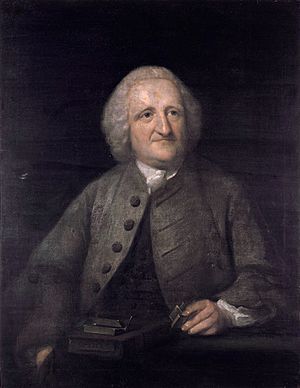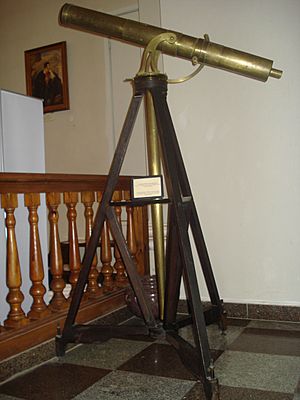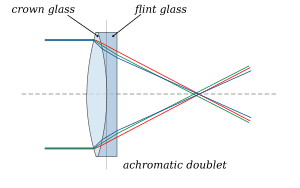John Dollond facts for kids
Quick facts for kids
John Dollond
|
|
|---|---|
 |
|
| Born | 21 June 1706 |
| Died | 30 November 1761 (aged 55) |
| Nationality | English |
| Known for | Achromatic doublet |
| Awards | Copley Medal (1758) |
| Scientific career | |
| Fields | Optics astronomy |
John Dollond (born June 21, 1706 – died November 30, 1761) was a clever English optician. He became famous for his successful business making optical instruments. He is especially known for inventing and selling a special type of lens called the achromatic doublet. These special lenses helped make telescopes and other optical tools much clearer.
Contents
The Life of John Dollond
John Dollond was born in Spitalfields, London. His father was a Huguenot refugee who worked as a silk-weaver. John followed his father's trade for many years.
Even though he was a silk-weaver, John loved to learn. He taught himself many subjects. These included Latin, Greek, mathematics, physics, and anatomy.
In 1752, John decided to change his career. He joined his oldest son, Peter Dollond, in his business. Peter had started making optical instruments in 1750. Their business grew quickly and became very well-known. It was later called Dollond & Aitchison. By 1761, John Dollond was even named the official optician to the king!
Dollond's Amazing Lenses
John Dollond's most important work was with achromatic lenses. These lenses solve a problem called chromatic aberration. This is when colors in an image look blurry or have fringes around them. It happens because different colors of light bend at slightly different angles when they pass through a simple lens.
In 1758, Dollond published a paper about his experiments. He described how he found a way to make lenses that reduced this color distortion. He did this by combining two different types of glass: crown glass and flint glass.
Before Dollond, a scientist named Leonhard Euler had suggested that combining glass and water lenses might work. Sir Isaac Newton had also made statements about how light behaves. At first, Dollond thought it wasn't possible to fix the color problem.
However, a Swedish physicist named Samuel Klingenstierna showed that Newton's ideas about light dispersion didn't quite match some observations. This made Dollond start his own experiments.
In 1757, Dollond successfully made achromatic lenses. He first used glass and water. A few months later, he found a way to get the same result using only different types of glass. This was a big step forward in the history of telescopes.
For this important achievement, the Royal Society gave him the Copley Medal in 1758. Three years later, he was elected as a member of the Royal Society. Dollond also wrote papers about tools for measuring small angles.
Who Invented the Achromatic Lens First?
While John Dollond patented the achromatic doublet in 1758, he wasn't the very first person to make such lenses. Another optician named George Bass had made and sold similar lenses as early as 1733. Bass was following instructions from Chester Moore Hall.
In the late 1750s, Bass told Dollond about Hall's design. Dollond quickly saw how useful this invention could be. He was able to make his own versions of these special lenses.
Dollond knew about the earlier work. He didn't try to stop others from making the lenses while he was alive. However, after John Dollond died, his son Peter decided to enforce the patent.
Peter Dollond took legal action against other opticians who were making achromatic lenses. These included George Bass, Benjamin Martin, Robert Rew, and Jesse Ramsden. The court decided that Dollond's patent was valid. This was because Dollond had actively used and sold the invention, while the earlier inventors had not.
Sadly, some of the opticians lost a lot of money because of these legal battles. They had to close their shops. The patent remained valid until it expired in 1772. After the patent ran out, the price of achromatic doublets in England dropped by half.
See also
- Dollond & Aitchison
- List of astronomical instrument makers
- In Spanish: John Dollond para niños



